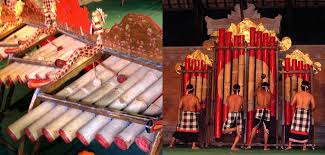Jegog
The gamelan jegog is one of the most impressive sounding ensembles in the world. It is an orchestra of bamboo marimbas, with keys (tubes) ranging from small to gigantic. The largest tubes, up to three meters long, are used for the bass jegog, for which the ensemble is named.
The resonant bass tones of the gamelan jegog can be hear heard a kilometer or more away in the (increasingly rare) quiet areas of Bali. Many unique forms of interlocking figuration have been developed for jegog, weaving complex melodic textures entirely within a strange four-tone scale, used for no other gamelan in Bali.

The ensemble was created in the early twentieth century in the western district of Jembrana, where bamboo of such dimensions grows. Now there are several sets in other parts of Bali (and outside of Indonesia, such as GSJ’s), though most would-be owners must go to Jembrana to find the bamboo, instrument builders, and teachers. The passionate playing intensity and ensemble perfection of the Jembrana groups continue to inspire all who witness them.
The music of the gamelan jegog is energetic and powerful. Part of the energy derives from the sheer physical strength needed to play the heavy instruments. The lowest pitched jegog is so large that its two players must squat on a plank above the tubes; they often use both hands to wield the heavy rubber mallets. But another source of this energy certainly derives from its most popular performance tradition, jegog mabarung, a battle-of-the-bands competition between two groups. In this charged atmosphere, speed, precision, exuberance and power are winning traits. While mabarung are also held—quite famously—between kebyar groups, their competitive style is of a different order, seldom showing the uninhibited frenzy found in jegog mabarung. Before one group is finished, the other will burst in with its own piece; both then play as furiously as possible in a contest of endurance, concentration, and group virtuosity. For the audience, their unsynchronized tempi and sheer volume create a pulsating, phase-shifting wall of sound.
Gamelan jegog doesn’t only perform in competitions. It is also played in concert performances that might include dances derived from pencat silat, the Indonesian martial art form popular in West Bali. In this context a clowning Master of Ceremonies, called dag, often appears. The dag weaves his way through the performers between (and during) the acts, commenting, joking, and mocking the stage action. Gamelan jegog also accompanies the annual buffalo races, which take place in Negara, the capital of Jembrana.
A full gamelan jegog consists of the following percussion instruments, each with eight bamboo tubes:
Three barangan, seated in front play the main melody. The middle barangan, which leads the ensemble, plays a decorated version on the beat. The outer players play off the beat.
Three kantilan and, an octave higher, three suir, all playing interlocking figuration.
Two undir and, an octave higher, two celuluk, playing the bun (melody). Players alternate between right and left hands playing paired slightly detuned pitches.
One jegog, an octave lower than undir, with two players executing the bun also playing paired detuned pitches.
Suling (bamboo flutes) often embellish the bun. On occasion, usually when accompanying dance, there might also be kendang (drums), ceng-ceng (cymbals) and tawa-tawa (a beat-keeping small gong) .
The four-tone tuning of gamelan jegog is unique in Bali. Although this scale can be roughly imitated by selecting certain pitches of the seven-tone pelog scale (#2, 3, 5, and 7), this connection seems more accidental than causative, considering the disparate lines of historical and musical development between 7-tone court genres and West Balinese traditions.



